
The Atlas of Peculiar Galaxies is a catalog of peculiar galaxies produced by Halton Arp in 1966. A total of 338 galaxies are presented in the atlas, which was originally published in 1966 by the California Institute of Technology. The primary goal of the catalog was to present photographs of examples of the different kinds of peculiar structures found among galaxies.
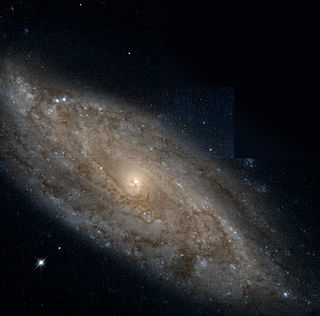
NGC 7314 is a spiral galaxy located in the southern constellation of Piscis Austrinus. It was discovered by English astronomer John Herschel on July 29, 1834. This is a nearby Seyfert (active) galaxy, located at a distance of approximately 54.6 megalight-years from the Milky Way. Since it appears to have detached spiral arm segments, it was listed in Halton Arp's Atlas of Peculiar Galaxies.

Arp 87 is a pair of interacting galaxies, NGC 3808A and NGC 3808B. They are situated in the Leo constellation. NGC 3808A, the brighter, is a peculiar spiral galaxy, while NGC 3808B is an irregular galaxy.

NGC 3432 is an edge-on spiral galaxy that can be found in the northern constellation of Leo Minor. It was discovered by German-British astronomer William Herschel on March 19, 1787. This galaxy is located at a distance of 40 million light-years (12.3 Mpc) from the Milky Way. It is interacting with UGC 5983, a nearby dwarf galaxy, and features tidal filaments and intense star formation. Because of these features, it was listed in Halton Arp's Atlas of Peculiar Galaxies.

NGC 935 and IC 1801 are a pair of interacting galaxies within the Aries constellation. They were discovered on 18 September 1885 by Lewis Swift. NGC 935 is the northern member of the pair, and IC 1801 is the southern. Together, they are listed in Halton Arp's Atlas of Peculiar Galaxies as Arp 276, as an example of interacting galaxies.
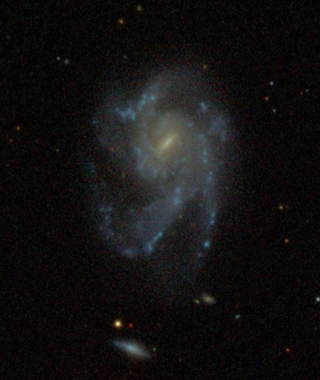
NGC 5579 is an intermediate spiral galaxy in the northern constellation of Boötes. It was discovered on May 1, 1785) by German-British astronomer William Herschel. The galaxy is located at a distance of 179 ± 14 million light-years (54.9 ± 4.3 Mpc) from the Milky Way, and is receding with a heliocentric radial velocity of 3,608 km/s. It is entry 69 in Halton Arp's Atlas of Peculiar Galaxies.

NGC 14 is an irregular galaxy in the Pegasus constellation. It was included in Halton Arp's Atlas of Peculiar Galaxies, under the section "Galaxies with the appearance of fission," since the irregular appearance of this galaxy causes it to look like it is coming apart. It was discovered on September 18, 1786, by William Herschel.

NGC 1023, also known as the Perseus Lenticular Galaxy, is a barred lenticular galaxy, a member of the NGC 1023 group of galaxies in the Local Supercluster. Distance measurements vary from 9.3 to 19.7 million parsecs (30 to 64 million light-years). The supermassive black hole at the core has a mass of (4.4±0.5)×107 M☉. The black hole was discovered by analyzing the dynamics of the galaxy.
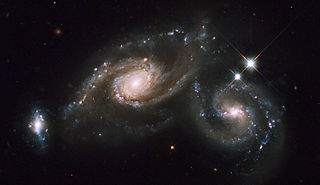
The NGC 5679 group, also known as Arp 274, is a triplet of galaxies, MCG+1-37-36, MCG+1-37-35 and MCG+1-37-34, spanning about 200000 light-years and at some 400 million light-years from Earth in the constellation Virgo. Arp 274 refers to the Atlas of Peculiar Galaxies, compiled by Halton Arp in 1966. Galaxies 269 through 274 in his catalogue are galaxies that appear to have connected arms.

NGC 7714 is a spiral galaxy in the constellation Pisces. Its velocity with respect to the cosmic microwave background is 2430 ± 26 km/s, which corresponds to a Hubble distance of 116.9 ± 8.3 Mly (35.85 ± 2.54 Mpc). In addition, five non-redshift measurements give a distance of 92.24 ± 8.69 Mly (28.280 ± 2.664 Mpc). It was discovered by British astronomer John Herschel on 18 September 1830.

Arp 273 is a pair of interacting galaxies, 300 million light years away in the constellation Andromeda. It was first described in the Atlas of Peculiar Galaxies, compiled by Halton Arp in 1966. The larger of the spiral galaxies, known as UGC 1810, is about five times more massive than the smaller galaxy. It has a disc that is tidally distorted into a rose-like shape by the gravitational pull of the companion galaxy below it, known as UGC 1813. The smaller galaxy shows distinct signs of active star formation at its nucleus, and "it is thought that the smaller galaxy has actually passed through the larger one."

Arp 7 is a spiral galaxy in the constellation Hydra. Redshift-independent measurements of its distance vary widely, from 5.9 Mpc to 83.7 Mpc. Its morphological classification is SB(rs)bc, meaning it is a barred spiral galaxy with some ring-like structure.

NGC 2857 is a spiral galaxy in the constellation Ursa Major. It was discovered on January 9, 1856, by R. J. Mitchell.

NGC 191 is a spiral galaxy located in the constellation Cetus. It was discovered on November 28, 1785, by William Herschel.
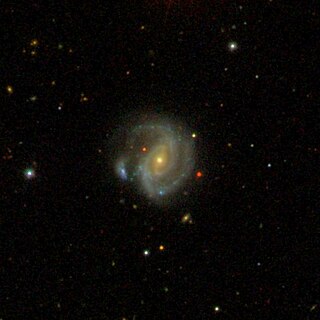
NGC 341 is a spiral galaxy in the constellation Cetus. It was discovered on October 21, 1881 by Édouard Stephan. It was described by Dreyer as "faint, pretty large, round, a little brighter middle, mottled but not resolved." It has a companion galaxy, PGC 3627, which is sometimes called NGC 341B. For this, reason, it has been included in Halton Arp's Atlas of Peculiar Galaxies.

NGC 507, also known as Arp 229, CGCG 502-67, MCG 5-4-44, PGC 5098, UGC 938, and V V 207, is a lenticular galaxy in the constellation Pisces. It was described as being "very faint", "pretty large", "round", "brighter in the middle", and "south of NGC 508" by John Dreyer in the New General Catalogue. The two galaxies are a part of the Atlas of Peculiar Galaxies, where NGC 507 is described as "Circular or near circular rings of small density difference."
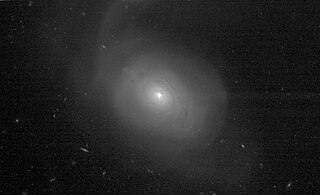
NGC 7603 is a spiral Seyfert galaxy in the constellation Pisces. It is listed in the Atlas of Peculiar Galaxies. It is interacting with the smaller elliptical galaxy PGC 71041 nearby.

NGC 497 is a barred spiral galaxy approximately 336 million light-years away from Earth in the constellation of Cetus. It was discovered by French astronomer Édouard Stephan on November 6, 1882.

NGC 6040 is a spiral galaxy located about 550 million light-years away in the constellation Hercules. NGC 6040 was discovered by astronomer Édouard Stephan on June 27, 1870. NGC 6040 is interacting with the lenticular galaxy PGC 56942. As a result of this interaction, NGC 6040's southern spiral arm has been warped in the direction toward PGC 56942. NGC 6040 and PGC 56942 are both members of the Hercules Cluster.

NGC 2300 is a lenticular galaxy in the constellation Cepheus. Its velocity with respect to the cosmic microwave background is 1876 ± 7 km/s, which corresponds to a Hubble distance of 90.2 ± 6.3 Mly (27.67 ± 1.94 Mpc). However, 11 non redshift measurements give a distance of 131.98 ± 21.75 Mly (40.464 ± 6.668 Mpc). The galaxy was discovered in 1871 by French astronomer Alphonse Borrelly using an 18 cm telescope.




















